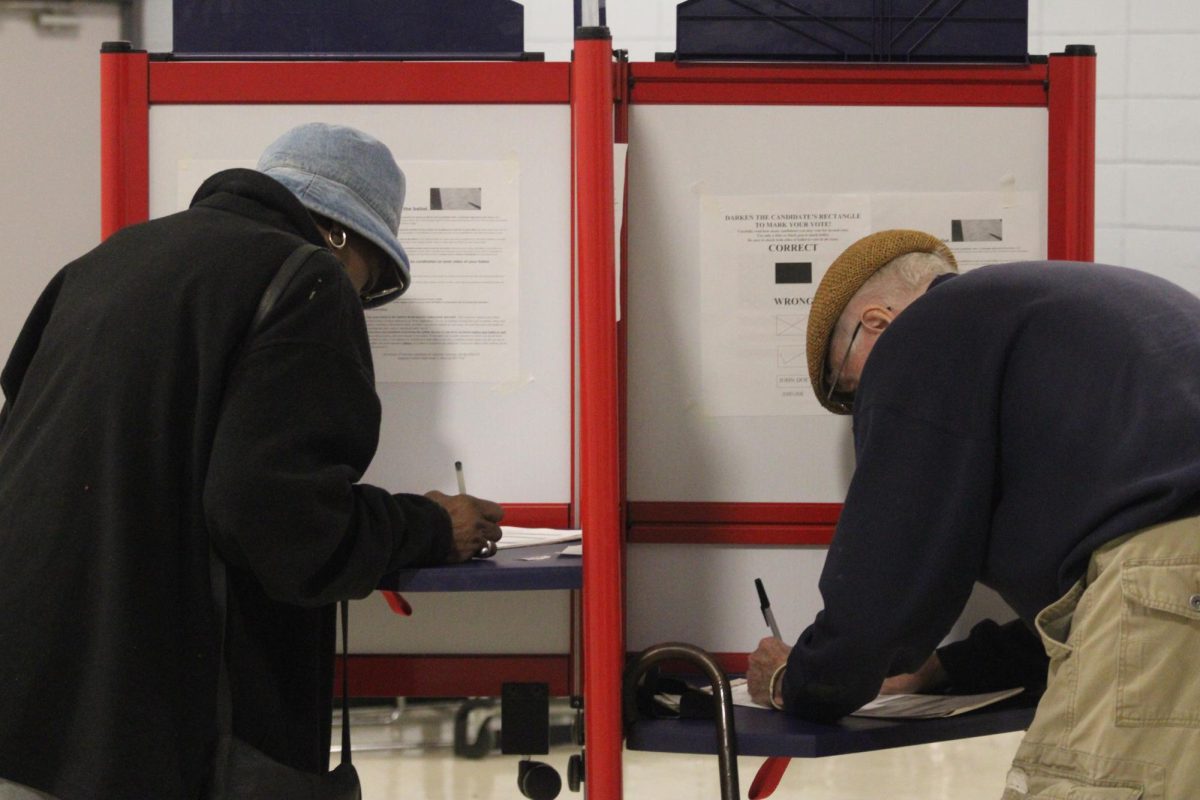Looking to 2020, both Democrats and Republicans see costs and benefits of Trump’s ‘MAGA’ rallies in midterm election results
December 4, 2018
Fresh off the midterm elections, and now gearing up for 2020, both parties are grappling with one of the most confounding spectacles in modern politics: President Donald Trump’s free-wheeling rallies.
Not Trump. He believes they are so valuable to Republicans that he held two in one night Monday, to help embattled Sen. Cindy Hyde-Smith win a surprisingly competitive Senate runoff election in Mississippi on Tuesday. At each, he boasted that his performances in past months _ filling arenas in other red states, in mid-sized cities and rural outposts _ had not only preserved but enlarged Republicans’ Senate majority.
He took no blame for the party’s overwhelming loss of its House majority. For Republicans, that split result _ and the party’s losses more broadly _ leaves them conflicted. Some Democrats, however, believe they may have solved part of their riddle: Do the rallies help Republicans more, by mobilizing Trump voters, or do they benefit Democrats, by inciting Trump critics to vote?
Advertisement
Their short answer is, it depends _ on where Trump goes, and how Democrats counter his impact.
Months before the election, Democrats used a central Ohio House district near Columbus as a political test kitchen. They polled extensively during a one-week period in the dead of summer, before and after a Trump rally for Troy Balderson, a Republican who ultimately held off Democrat Danny O’Connor in a close special election there.
The insights helped guide Democrats’ strategy in winning up to 40 additional seats and control of the House this month, and will undoubtedly influence their efforts ahead of November 2020 to build on their gains in state and federal races as well as to compete for the White House.
The Ohio polling showed an uptick in enthusiasm among Trump’s most loyal supporters after the rally, but no significant effect on the overall standing of each candidate. Democrats, independents and moderates were largely unmoved by the president’s visit.
That suggested that in a close race where moderates are the swing votes, Trump is unlikely to help. But in a state or district with a significant majority of Republicans, he can bring home a win for his party, giving it an opportunity to use the temporary burst of enthusiasm to sign up volunteers and encourage early voting, where that’s an option, before the excitement fades.
Many Democrats are now convinced they can best counter Trump’s power to rally his voters with a twofold strategy. One, they need to give moderate swing voters affirmative reasons to support Democrats, even as Trump’s polarizing personality remains the driving force for many other voters who simply want to oppose him and his party.
But also, they must broaden their potential paths to victory _ competing in more states and taking few for granted in the presidential race, while in lower-ballot contests supporting candidates of diverse views _ to protect against Trump’s ability to unexpectedly shake up the political terrain.
Advertisement*
Interviews with political leaders, consultants and candidates in both parties largely validated the Democrats’ Ohio analysis. Trump focused almost exclusively on deep-red states where he was able to help his party pick up a net of two Senate seats. He ignored most of the House races, given his unpopularity especially in competitive suburban districts, leaving Democrats not only to win control of the chamber, but also to make significant gains in governors’ mansions and state houses.
“People entered the 2018 election with pretty strong views of the president, one way or another,” said Bruce Mehlman, a Republican strategist and lobbyist who publishes a widely read political analysis. “The rallies didn’t change them. But the rallies allowed the president to make the election a referendum on him.”
That worked in places where Trump is popular. Yet his ability to excite voters who attended rallies or watched them on livestream comes with a downside. His most strident messages spread far beyond the arenas, exacerbating the challenge for his party’s most vulnerable candidates, especially among college-educated suburban women and in states with large minority populations.
“It’s obviously not just the rallies, but more broadly the president’s rhetoric,” said Rep. Carlos Curbelo, a moderate Miami Republican who lost his election despite his efforts to distance himself from the president _ figuratively and literally.
When Trump held a rally in Florida on Halloween, Curbelo was elsewhere, taking his kids trick-or-treating. When Trump came a second time three days before the election, Curbelo instead visited early-voting sites.
Yet it didn’t matter whether Trump held rallies in Fort Myers, Fla., or Fort Wayne, Ind., in Curbelo’s view _ voters heard the same “fear-mongering” from the president, he said.
“Instead of talking about caravans and birthright citizenship, imagine talking about ways for Democrats and Republicans finding a way to work together to secure the border and a future for Dreamers in our country,” Curbelo said, referring to people who years ago were brought into the country illegally as children.
Utah Republican Rep. Mia Love, the party’s first and only black woman in Congress, on Monday delivered an angry rebuke to Trump, who’d publicly mocked her for not accepting his “embrace.” She complained that he has “no real relationships,” only transactional ones, and that the Republican Party never takes “minority communities into their home.”
Rep. Ryan Costello, a Pennsylvania Republican who chose not to seek reelection after his district was redrawn and favored Democrats, said Trump’s rallies nationalized the election around the president more than any midterm contests in recent memory, creating “a cult of personality referendum.”
The Trump-centered election made it nearly impossible for vulnerable Republicans such as California’s Rep. Jeff Denham to talk about water policy that mattered in his Central Valley district or for Rep. Leonard Lance of New Jersey to distinguish himself from the president by emphasizing his differences with Trump on healthcare or taxes.
As Costello said: “There’s always a sound bite the next morning” and a question about “whatever the most ridiculous thing he said” is.
“Are you going to speak out or just try to ignore it?” Costello said. “When everyone else is talking about it, it’s hard for you to penetrate the conversation. And it was increasingly a national conversation.”
Dan Sena, the executive director of the Democratic Congressional Campaign Committee, said the party built on the lessons from the Ohio special election in August by using focus groups and extensive polling that measured the enthusiasm of swing voters and people of color in 60 to 70 congressional districts.
He said the party wanted to prepare for those moments when Trump would “shake the snow globe” _ by making an incendiary comment or introducing a controversial new policy that would steal attention and alter the dynamics of individual races.
The biggest takeaway, Sena said, was that Democrats needed to broaden the battlefield and have a variety of paths to a House majority because Trump could redefine which House seats were winnable with a single comment. While Trump often makes news on Twitter or while speaking to reporters, his rapturous rallies tend to bring out his most extreme rhetoric.
“‘Rally Trump’ is peak, over-the-top, demagoguery Trump,” said Rob Stutzman, a Republican consultant based in California.
Trump largely did succeed in galvanizing his voters. Besides the slight gains in the Senate, Trump helped Republicans hold on to House seats in North Carolina and parts of Florida with high concentrations of conservative and evangelical voters. Trump also helped secure close victories in statewide races in Florida and Georgia, two states he won in 2016.
But the same anti-immigration rhetoric that motivated many of those voters helped Democrats pick up seats in places such as California, where millennial voters defied the historical pattern of midterm elections and turned out in larger proportion than they did in 2016, a presidential year. Latino voters’ 2018 turnout was equal to that election.
“That’s exactly why we needed the big battlefield,” Sena said. Trump, he added, “was speaking to the base and he was making sure they got out and participated. Some of these congressional races, there just aren’t enough Democrats” for their candidates to win if Republicans’ turnout is high.
Hillary Clinton followed some of that advice in 2016, trying to make gains in the Sun Belt. But she failed to recognize Trump’s popularity in the Midwest, and neglected campaigning in Michigan, Wisconsin and other states Democrats expected to win. This year, Democrats worked hard and made big gains in the upper Midwest. Republicans took solace in winning the Ohio governor’s race.
“The challenge for this White House is how do you grow your base?” said Mehlman. “Rallies are a tactic that excite your base. They don’t grow your base.”
(c)2018 Los Angeles Times
Visit the Los Angeles Times at www.latimes.com
Distributed by Tribune Content Agency, LLC.
Advertisement








